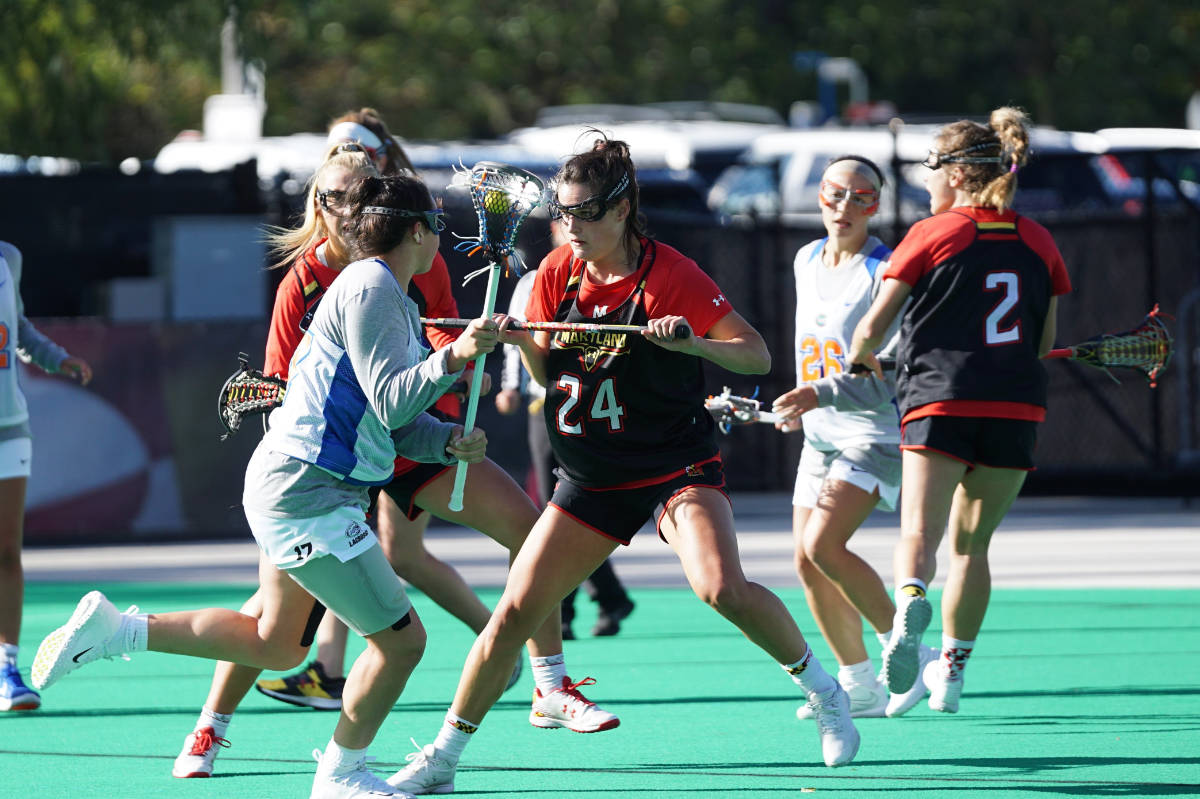A lot of good defense comes from confidence. If you have the confidence to stand your ground and own your space, you’re already halfway there. However, here are a few tips on how best to position your body when you’re on defense to help with stopping those goals!
Defense in the 12-Meter
If the opposing team has the ball and they’re in your zone, the pressure is on for you to shut down their offense. Depending on where the attackers are, there are different levels of pressure that you can apply. If they’re around the 12-meter, you can maintain some distance since the threat of scoring isn’t as high as inside the 8-meter.
The number one rule while defending, whether it’s the 12-meter or 8-meter, is to always be between the player and the goal! This is the least you can do while on defense, and it’s the most effective starting point.
While around the 12-meter, your body should still be ready for any cuts and dodges your mark might make. Your hips shouldn’t be square to hers, this allows a higher chance of her making you stumble as she tries to get around you. By staying on the balls of your feet and shifting your hips, you lower the risk of tripping over your own feet. Your hips and feet should be ready for any movement. Since they’re farther away from goal, you don’t have to stand right next to your player when they’re at the 12-meter. Position yourself about a stick’s length away from the attacker and give yourself room to react if they attempt to cut.
As the offense passes and cuts around the 12-meter, your stick can be loose in your hand. Make sure it’s obvious who you are guarding; don’t keep your stick down and to yourself. Communicate to your teammates who you are covering so there’s no guesswork. Holding your stick up high can also cause a turnover by knocking down any passes. I personally would often hold my stick at the very bottom with one hand, so it was as high as possible; I’m on the shorter side, so this helped give me some height too. You should be giving the offense as few possibilities and chances to pass and score as you can.
Defense in the 8-Meter
The closer the attackers get to goal, the more pressure you should be putting on them. As they run into the 8-meter, your stick should go from up in the air to close to their body. Make sure to get two hands on your stick so you have better control. This will allow you to mirror her stick better and perform a safer check if there’s an opportunity. Mirroring her stick is exactly what it sounds like. While guarding a ball carrier up close, your stick should be following her stick wherever it goes. If she goes for a pass, your stick will be there to, hopefully, intercept it. Doing this helps keep you ready at all times for anything.
You can use your body positioning to also increase the pressure as they near the goal. In the 8-meter, your body should be closer to the attacker’s than when they were in the 12-meter. Don’t be afraid to get close; give her as little room as you can, she won’t be able to score if she has no room. While it’s illegal to push, you can still be aggressive with your body positioning. It isn’t illegal to touch the player you’re guarding. If keeping your arm on her arm helps to follow her movements, then do that! Sometimes defenders will hold their arms out in a circle in front of them with their knuckles against the attacker’s arm, we called that hugging the tree. Creating space with your arms will accentuate any movement from the offense; if they push towards you, that space collapses and the ref can call that as a charge.
Whenever I was on attack, I would come away from a game with bruises up and down my upper arm from defenders marking me. They never made an illegal move, but they were aggressive. You don’t have to give the attacker bruises, but stand your ground!
Guiding Your Attackers
Once the attackers get into the 8-meter, your immediate instinct should be to push her to the sides of the zone. Directly in front of the goal is the best place to make a shot. The further you push her to the sides, the worse the shooting angle becomes. Think of the space in front of the goal as a no fly zone.
To help with guiding the offense to the sides, keep your hips towards the direction you’d like to go. When you turn your hips and stand your ground, it’ll be hard for the attacker to go against that direction.
Defense on the Move
Similar to guiding the attackers to the sides of the 8-meter, when you are running down the field, try to guide your player with your hips. Whether it’s toward another player so you can double team or simply to the side of the field to cut off her opportunities, try to avoid simply running with her. When you’re on the move, it can be hard to keep control of the attacker, like you can when the play has settled on the 12-meter. This is where checks come in handy. It’s an extra tool you can keep in your arsenal as a last resort to intercept. If you go for the check, make sure it’s away from her body, same with the follow-through.
Body Positioning in Defense Wrap Up
When defending a player in lacrosse, always make sure your body is ready for any cuts and dodges. Stay on the balls of your feet and never square your hips to the attacker. Use tools like checking and double teaming when necessary and always make sure to stay in between the player and the goal! Be aggressive (within the rules) and have confidence, after all that’s YOUR zone!

